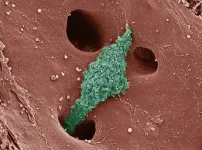(Press-News.org) Most people — up to 94% of U.S. adults — experience at least some dulling of their senses with age, finding themselves squinting at screens, craving stronger flavors, and missing snatches of conversations more and more frequently. Researchers at the University of Chicago Medicine are looking into how these changes can go beyond mere inconvenience and actually worsen overall mental health in older adults.
“When your senses decline, you can't experience the world as well,” said Jayant Pinto, MD, a physician and expert in olfactory dysfunction at UChicago Medicine. “You can't hear colleagues or friends at the dinner table; you can't discern what's going on in your environment; you may have a hard time reading or making things out when you’re in your neighborhood. It makes all your cognitive burdens a little harder, and that probably wears you down over time and causes mental health problems.”
Along with Alexander Wang, a medical student at the UChicago Pritzker School of Medicine, Pinto recently led a study examining the prevalence and impact of sensory impairments among older adults. They found that people with sensory disabilities tend to have worse mental health, and that different types of sensory disability were associated with different aspects of mental health.
Revealing associations between perception and emotion
The UChicago researchers analyzed data on sensory function (vision, hearing and sense of smell) and self-reported mental health from nearly 4,000 older adults, collected over 10 years of follow-up as part of the National Social Life, Health & Aging Project. They found that people who had multiple senses impaired experienced more loneliness and had significantly worse self-reported mental health overall, and people with three sensory disabilities were more likely to experience frequent depressive episodes. In analyses that differentiated between the senses, vision impairment was most strongly associated with both loneliness and poor self-rated mental health.
Scientists are still exploring how changes in all five senses can impact people, but the UChicago researchers can already point to many ways sensory decline contributes directly to feelings of loneliness, sadness and boredom.
Older people with vision impairment may have trouble getting out of the house or seeing the faces of their friends and family, and hearing loss can make conversations stilted and frustrating. Even loss of smell can affect someone’s ability to find joy in familiar scents — like a favorite home-cooked meal or a loved one’s signature perfume — and perceive pheromones, which (though not registered consciously) contribute to social dynamics.
“We saw that hearing and vision disability tended to be associated with lower self-rated mental health and feelings of loneliness, but olfactory disability had a weaker association,” Wang said. “This stood out to me because hearing and vision disabilities tend to be much more stigmatized than olfactory disability. This made me reflect on the ways in which social stigma may be driving this worse mental health.”
Caring for one another in an aging society
In the face of that stigma, the researchers say their results highlight the importance of improving access to mental health services and increasing awareness of the connection between sensory loss and mental distress. In particular, understanding how different sensory disabilities impact the long-term mental health of older adults could help healthcare professionals — especially primary care providers, otolaryngologists and ophthalmologists — screen for mental health conditions when they identify sensory loss in their patients, providing opportunities for personalized and timely interventions.
In addition to proactively treating older adults’ mental health, the researchers pointed to steps that can be taken to directly lessen the day-to-day effects of sensory difficulties, which would in turn lessen their negative mental health implications.
“We have an aging society; everybody has a relative who's getting older and having a harder time in life. It’s a burden for us all to share,” Pinto said. “Lessening the burdens of your aging relatives and friends can have a huge impact on people's lives, their productivity and their quality of life.”
On a personal level, family members and friends can help by being patient and finding ways to communicate more effectively, such as speaking clearly or using written notes. On a societal level, public policies and community programs can ensure accessibility in public spaces and provide resources that improve quality of life.
Pinto also highlighted a wide range of technologies and medical interventions are available that can help compensate for sensory impairment. For hearing loss, there are cochlear implants, hearing aids and other hearing-assistive devices — which research has indicated could slow cognitive decline in addition to improving quality of life. For vision loss, there are glasses, contacts, cataract surgery and LASIK surgery, along with accommodations like text-to-speech computer programs. Even for the sense of smell, health experts can sometimes help by reducing sinus inflammation or conducting smell training exercises.
“In many cases, we can mitigate sensory difficulties in ways that might actually improve people's lives, mental health and sense of loneliness — which is a huge epidemic,” Pinto said. “These are simple ways we can intervene to help people and potentially have a huge impact on society.”
Recognizing and destigmatizing sensory disability
The researchers said they intentionally used the word “disability” throughout the paper to underscore the significant impact of sensory impairments on individuals' lives. This terminology also aligns with efforts to destigmatize these conditions and promote a more inclusive approach to healthcare.
“To some extent, our society already considers decreased sensory function to be a disability: think of the blind and d/Deaf communities,” Wang said. “Like many marginalized communities, the disabled community has historically had a very contentious relationship with the medical field, which can cause distress and limit access to mental health services. With better understanding and compassion, we can strive to improve the care we provide to older adults and disabled patients.”
He said that by framing the data this way, he hopes to encourage more healthcare providers to move away from thinking in terms of the Medical Model of Disability and move towards the Social Model of Disability.
“My understanding is that the Medical Model characterizes disability as something that is ‘deficient’ with a person, thus requiring some sort of ‘fixing’ of the individual,” he explained. “The Social Model characterizes disability as more of an identity, so limitations relating to disability stem from a society’s lack of accessibility and accommodation for disabled people.”
Recognizing sensory impairments as disabilities and acknowledging their impact on mental health are important steps toward more comprehensive and compassionate care. By addressing the medical, social and environmental barriers that exacerbate these impairments, clinicians — and society as a whole — can better support older adults in maintaining their independence.
END
Declining senses can impact mental health and loneliness in aging adults
2024-08-23
ELSE PRESS RELEASES FROM THIS DATE:
NASA’s EXCITE mission prepared for scientific balloon flight
2024-08-23
Scientists and engineers are ready to fly an infrared mission called EXCITE (EXoplanet Climate Infrared TElescope) to the edge of space.
EXCITE is designed to study atmospheres around exoplanets, or worlds beyond our solar system, during circumpolar long-duration scientific balloon flights. But first, it must complete a test flight during NASA’s fall 2024 scientific ballooning campaign from Fort Sumner, New Mexico.
“EXCITE can give us a three-dimensional picture of a planet’s atmosphere and temperature by collecting data the whole time the world orbits its star,” said Peter Nagler, the mission’s principal ...
New gels could protect buildings during wildfires
2024-08-23
As climate change creates hotter, drier conditions, we are seeing longer fire seasons with larger, more frequent wildfires. In recent years, catastrophic wildfires have destroyed homes and infrastructure, caused devastating losses in lives and livelihoods of people living in affected areas, and damaged wildland resources and the economy. We need new solutions to fight wildfires and protect areas from damage.
Researchers at Stanford have developed a water-enhancing gel that could be sprayed on homes and critical infrastructure to help keep them from burning during wildfires. The research, published Aug. ...
U.S. National Science Foundation awards UT $18 million to study factors that lead to pandemics
2024-08-22
Professor of Ecology and Evolutionary Biology Nina Fefferman became a mathematician because she loves puzzles. She’s just been awarded $18 million from the U.S. National Science Foundation to solve one puzzle that has the potential to change the world: how, when and why an infection in a population will spread, or cause an epidemic or pandemic, rather than dying out.
Fefferman, director of the National Institute for Modeling Biological Systems and associate director of the UT One Health Initiative at the University ...
Mosquitoes sense infrared from body heat to help track humans down
2024-08-22
(Santa Barbara, Calif.) — While a mosquito bite is often no more than a temporary bother, in many parts of the world it can be scary. One mosquito species, Aedes aegypti, spreads the viruses that cause over 100,000,000 cases of dengue, yellow fever, Zika and other diseases every year. Another, Anopheles gambiae, spreads the parasite that causes malaria. The World Health Organization estimates that malaria alone causes more than 400,000 deaths every year. Indeed, their capacity to transmit disease has earned mosquitoes the title of deadliest ...
DOD grants CU researchers $5 Million to study antibiotic-resistant wound infections in Ukraine
2024-08-22
Faculty members in the Department of Emergency Medicine at the University of Colorado School of Medicine have been awarded $5 million by the U.S. Department of Defense to work with partners in Ukraine on clinical and logistical challenges associated with modern large-scale combat operations and prolonged casualty care.
The overarching program — Research and Scalable Infrastructure to Improve Outcomes on the Front Lines of Ukraine by Advancing Treatment and Evaluation (RESOLUTE) — is focusing on collecting data related to antibiotic-resistant wound infections, which have substantially increased amid the military conflict.
The initial project — ...
3D body volume scanner uses AI to help predict metabolic syndrome risk
2024-08-22
ROCHESTER, Minn. — Mayo Clinic researchers are using artificial intelligence (AI) with an advanced 3D body-volume scanner – originally developed for the clothing industry – to help doctors predict metabolic syndrome risk and severity. The combination of tools offers doctors a more precise alternative to other measures of disease risk like body mass index (BMI) and waist-to-hip ratio, according to findings published in the European Heart Journal - Digital Health.
Metabolic syndrome can lead to heart attack, stroke and other serious health issues and affects over a third of the U.S. population and a quarter of people globally. ...
Building a COMPASS to navigate future pandemics
2024-08-22
Viruses like SARS-CoV-2 don’t respect boundaries, moving between species and continents and leaving destruction as they go. Beating the next pathogen with pandemic potential means getting good at crossing borders ourselves — between fields of study, between research universities, and between scientists and the wider community.
An $18 million grant announced by the U.S. National Science Foundation (NSF) will put that goal within reach. The award brings together five universities and more than 20 researchers, academics, and public health experts to establish the Virginia Tech-led Center ...
Macrophage mix helps determine rate and fate of fatty liver disease
2024-08-22
Formerly known as nonalcoholic steatohepatitis, metabolic dysfunction-associated steatohepatitis (MASH) is an inflammatory disease characterized by liver scarring or fibrosis that progressively impairs liver function.
It is a major risk factor for cirrhosis and liver cancer. And because treatment options are limited, MASH is the second leading cause for liver transplants in the United States after cirrhosis caused by chronic hepatitis C infection.
A better understanding of the pathological processes that drive MASH is critical to creating effective treatments. In a new paper published ...
Department of Energy announces $36 million to support energy-relevant research in underrepresented regions of America
2024-08-22
WASHINGTON, D.C. - Ensuring that scientific funding goes to states and territories that have typically received smaller fractions of federal research dollars in the past, the Department of Energy (DOE) today announced $36 million in funding for 39 research projects in 19 states via the Established Program to Stimulate Competitive Research (EPSCoR). The grants connect innovative ideas from scientists at eligible institutions with leading-edge capabilities at the DOE national laboratories.
Supporting scientists while building the expertise and capabilities critical for performing leading research ...
Analysis of 1,500 climate policies reveals only a small fraction achieved significant emission reductions
2024-08-22
A new machine learning analysis has revealed the most effective climate policies out of 1,500 implemented worldwide over the last two decades. Some of the success stories – numbered at about 63 – involve rarely studied policies and unappreciated policy combinations. “Our results provide a clear yet sobering perspective on the policy effort necessary for closing the remaining emissions gap of 23 billion tons carbon dioxide (CO2) by 2023,” write the authors. To achieve the Paris Agreement’s climate targets, it is essential to know which ...





